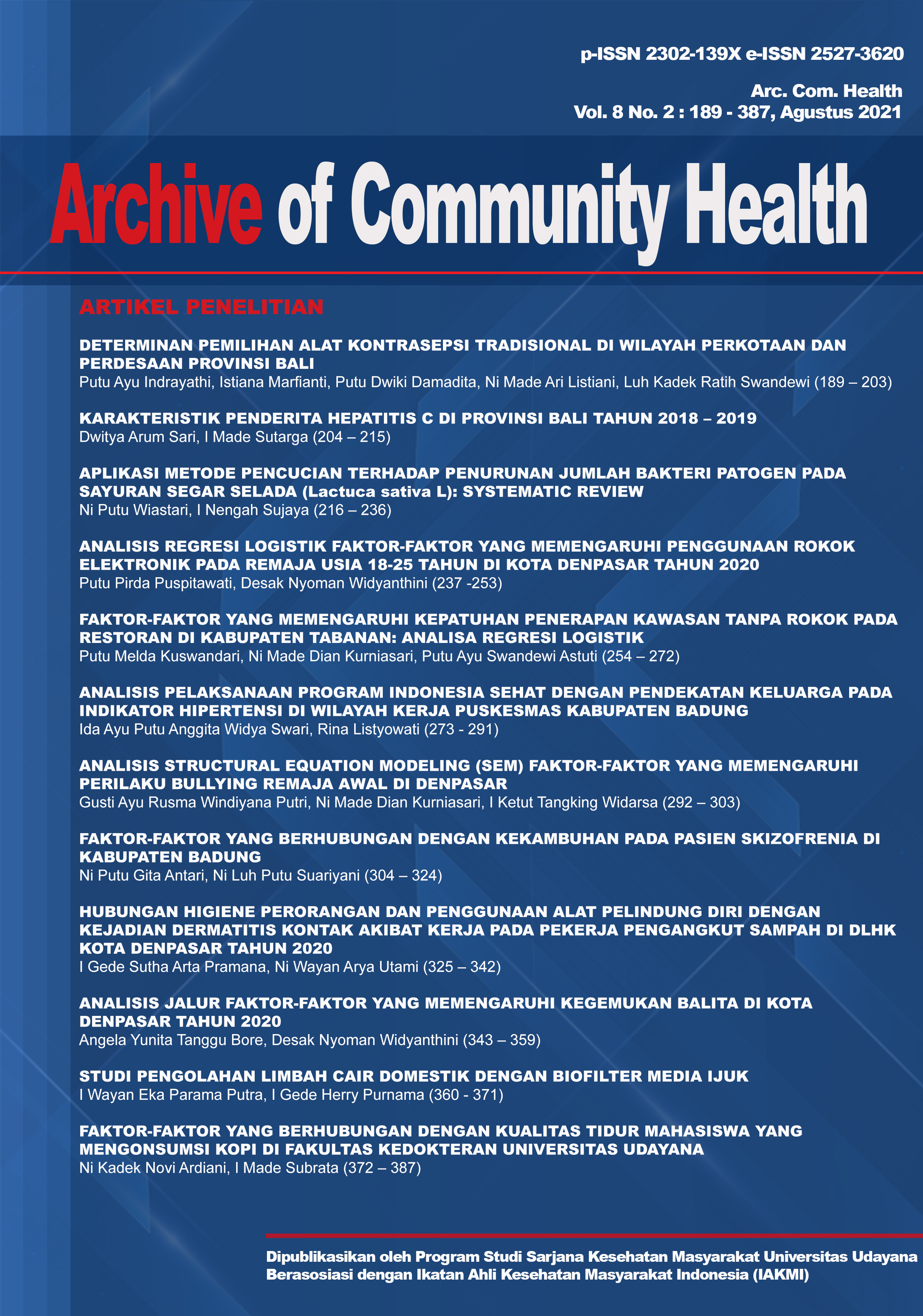ANALISIS PELAKSANAAN PROGRAM INDONESIA SEHAT DENGAN PENDEKATAN KELUARGA PADA INDIKATOR HIPERTENSI DI WILAYAH KERJA PUSKESMAS KABUPATEN BADUNG
Abstract
ABSTRAK
Program Indonesia Sehat dengan Pendekatan Keluarga (PIS-PK) terdiri dari 12 indikator salah satunya adalah indikator penderita hipertensi berobat secara teratur. Kabupaten Badung sudah terindeks pra sehat namun menduduki peringkat kedua terendah capaian indikator hipertensi berobat secara teratur (24,52 %) se Provinsi Bali. Tujuan penelitian untuk mengetahui pelaksanaan (PIS-PK) pada indikator hipertensi di wilayah kerja Puskesmas Kabupaten Badung khususnya dari segi input, proses dan lingkungan. Desain penelitian yang digunakan adalah penelitian deskriptif kualitatif. Penelitian dilaksanakan di Puskesmas Kuta II dan Mengwi III pada bulan Maret – Juli 2020. Jumlah informan 20 orang dipilih dengan purposive sampling. Pengumpulan data dengan wawancara mendalam dan FGD, kemudian dianalisis tematik. Validasi data dengan triangulasi sumber dan peer debriefing. Hasil penelitian yaitu input : SDM yang bertanggung jawab yaitu pemegang program hipertensi; tidak ada dana khusus untuk mendukung PIS-PK pada indikator hipertensi; Sarana prasarana pendukung berupa tensimeter, pinkesga dan alat tulis; metode berupa kunjungan keluarga; sasaran yaitu keluarga. Proses : Perencanaan berupa pembuatan tim dan jadwal tindak lanjut; Implementasi dilakukan dengan kunjungan, posbindu dan program inovasi; Monev melalui rapat minilok, pelaporan via aplikasi KS dan laporan bulanan. Lingkungan internal dan geografi tidak mempengaruhi program. Faktor ekonomi akan mempengaruhi gaya hidup masyarakat. Faktor sosial budaya mempengaruhi pelaksanaan program.
Kata Kunci: PIS-PK, Hipertensi, Puskesmas, Badung
ABSTRACT
The Healthy Indonesia Program with the Family Approach (HIP-FA) consists of 12 indicators, such as an indicator of hypertension sufferers taking medical treatment regularly. Badung regency has indexed pre-healthy. Nevertheless, Badung Regency occupies the fourth position with the highest number of hypertension sufferers and ranks the second lowest achievement indicator of hypertension for regular treatment (24.52%). This study aims to determine the implementation (HIP-FA) of hypertension indicators in Badung District Health Center, especially in terms of inputs, processes and outputs. The research design uses a qualitative descriptive study. The investigation takes place in Kuta II and Mengwi II Health Center from March - July 2020. The number of informants is 20 people that were selected through purposive sampling. The data was collected through in-depth interviews and FGD and analyze by thematic analysis. The data is validated by the triangulation of sources and peer debriefing. The research results which is the inputs: The HR responsible for the PIS-PK hypertension indicator is the holder of the hypertension program at the Public Health Center: There are no special funds to support PIS-PK on the hypertension indicators: Supporting equipment such as tensimeter, pinkesga and stationary: Method of family visit, the target is the family. Process: Planning in the form of team building and follow up schedule: The implementation is carried out by visiting Posbindu and innovation programs: M&E is conducted once and every 3 months through minilok meetings and reporting via the KS application and monthly reports. The internal environment and geography do not affect the program. Economic factors do not affect the implementation of the program but will affect people's lifestyles. Socio-cultural factors influence the implementation of the program.
Keywords: HIP-FA, Hypertension, Primary Health Care, Badung














